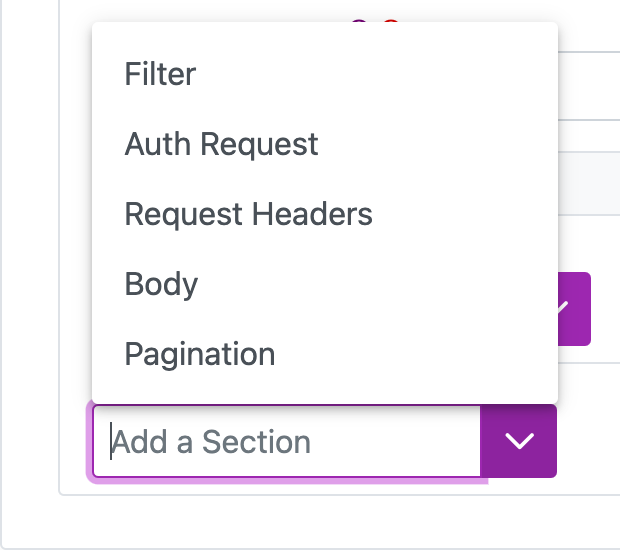Pagination
Pagination
When syncing a Data Source, you may have the option to add in extra configuration sections, such as an Pagination, under the "Add a Section" drop down tab in the Connection Experience (Image 1).

Cinchy has two types of pagination available (Image 2):
- Cursor: The cursor is a key parameter in this type of pagination. You receive a variable named
Cursoralong with the response. It's a pointer that points at a particular item that you must send with a request. The server then uses the cursor to seek the other set of items. Cinchy recommends using cursor-based pagination when dealing with a real-time data set. - Offset: Offset-based pagination is for parameters with a specific limit (the number of results) and offset (the number of records you need to skip). Cinchy recommends using offset-based pagination for static data.

Cursor pagination
To set up cursor pagination, fill in the following parameters (Image 3):
- Type: Select Cursor
- Next Page URL JSON Path: This is the JSON Path within the response to the URL of the next page
- Cursor Key: This is the key used in the query string to specify the cursor value. This is only required if the cursor returned isn't a fully qualified URL.

Offset pagination
To set up offset pagination, fill in the following parameters (Image 4):
- Type: Select Offset
- Limit Key: The key used in the query string to specify the limit
- Limit: The desired page size
- Offset By: The offset type that the API uses for pagination. This will be either Record Number or Page Number.
- Offset Key: The key used in the query string to specify the offset
- Initial Offset: The starting offset

caution
A pagination block is mandatory, even if the API doesn't return results from multiple pages. You can use the following as the placeholder:
<Pagination type="OFFSET" limitField="" offsetField="" limit="0" initialOffset="0" />
<RestApiDataSource
method="GET or POST"
format="JSON"
rootPath="$.result"
endpoint="https://data.com/api/v1/records/@recordId/details?apiKey=@apiKey">
<!-- optional -->
<RequestHeaders>
<Header name="" isEncrypted="true or false">value goes here</Header>
</RequestHeaders>
<!-- optional -->
<Body>body goes here, only relevant for POST operations</Body>
<!-- one of the following pagination blocks is required. If there's no pagination you still need a placeholder -->
<Pagination type="OFFSET"
limitField="name of the field in the querystring to use when passing the limit"
offsetField="name of the field in the querystring to use when passing the offset"
limit="20"
initialOffset="0">
<Pagination type="CURSOR"
pathInResponse="JSON path to the field in the response containing the next cursor value"
cursorPropertyName="name of the field in the querystring to use when passing the cursor">
<Schema>
<Column name="$.id" dataType="Text" />
<Column name="$.variants.field1" dataType="Text" />
<!-- you need to use the "item" placeholder if you're looking for fields in an array -->
<Column name="$.colors.item[1]" dataType="Text" />
<Column name="$.colors.item[2]" dataType="Text" />
</Schema>
</RestApiDataSource>